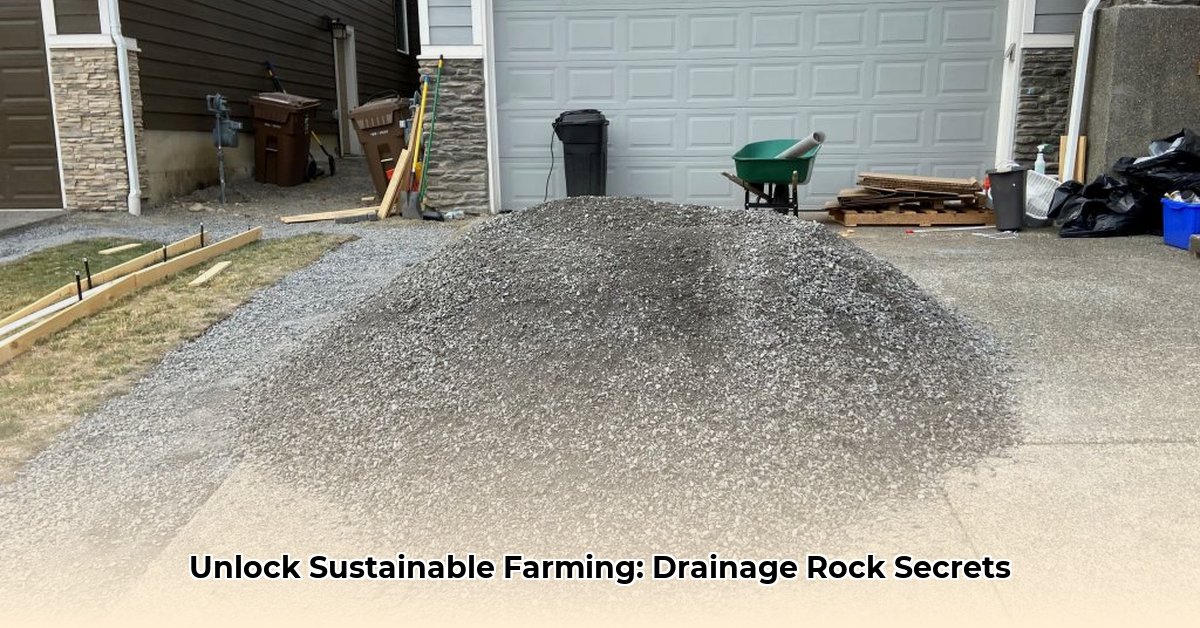
Improving drainage is crucial for healthy crops and thriving soil. Poor drainage leads to waterlogged roots, reduced yields, and increased susceptibility to diseases. Drainage rock, readily available at Tractor Supply, offers a practical solution for enhancing water flow and improving soil health. For more on fencing options to protect your improved land, check out these cattle fence panels. This guide provides a comprehensive overview of using drainage rock effectively, focusing on selection, installation, and long-term benefits for sustainable farming practices.
Understanding Drainage Rock and its Benefits
Drainage rock acts as a natural underground drainage system, improving water management across your land. Its effectiveness stems from three key mechanisms:
Accelerated Water Drainage: The spaces between the rocks allow water to permeate the soil more rapidly, preventing surface ponding and reducing waterlogging. This is particularly beneficial in heavy clay soils, which naturally retain more water. This improved drainage directly translates to healthier roots, more robust plants, and ultimately, higher yields.
Enhanced Soil Stability: The rocks help to stabilize the soil, significantly reducing erosion, particularly on sloped land. This prevents valuable topsoil from washing away, maintaining your soil's fertility and long-term productivity. Erosion control is a cornerstone of sustainable farming, and drainage rock plays a significant role.
Improved Soil Aeration: The porous nature of the rock allows for better air circulation within the soil. This improved aeration is vital for healthy root development and overall plant vigor. Adequate oxygen is critical for root growth, impacting nutrient uptake and overall plant health.
Selecting the Right Drainage Rock at Tractor Supply
Tractor Supply offers a range of drainage rock options. Choosing the appropriate type depends on several key factors:
Rock Size and Grading: Larger rocks generally facilitate faster drainage, making them ideal for heavily waterlogged areas. Smaller rocks offer more precise control and may be better suited for less severe drainage problems or gentler slopes. The size of the rock should be matched to the size of the drainage system you're creating.
Material Composition: While most drainage rocks are similar, slight variations in the material composition might exist. Always check product descriptions to ensure suitability for your specific soil type and drainage needs. Certain materials may better suit specific soils and applications.
Quantity Calculation: Accurate estimation of the required amount is vital. Insufficient rock will render the drainage system ineffective, while excess rock represents unnecessary expense. Measure the drainage area carefully and consult product information for quantity estimates (often expressed as cubic feet or cubic yards per square foot). Consult with Tractor Supply staff for personalized guidance on sizing your project.
Step-by-Step Drainage Rock Installation Guide
Implementing a drainage rock system is a achievable task with these clear steps:
Site Assessment: Identify specific areas with significant drainage challenges, often low-lying spots prone to water accumulation after rainfall. Accurate mapping of these areas is crucial for effective system design.
Trench Excavation: Dig trenches or channels in the problem areas. The depth and width will depend on the severity of the waterlogging and soil type. Deeper trenches may be necessary for clay soils or severe drainage issues.
Optional Filter Fabric (Geotextile): Consider using a filter fabric (geotextile) to line the trenches. This prevents soil from infiltrating the rock, extending the life and efficiency of the drainage system. Filter fabric is an optional but highly recommended addition.
Rock Placement: Carefully fill the trenches with the selected drainage rock, ensuring even distribution for consistent drainage. Even distribution is crucial for uniform water flow.
Backfilling and Compaction: Gently replace the removed soil, compacting it firmly to prevent settling and ensure the system's stability over time. Proper compaction is key to the longevity of the drainage system.
Post-Installation Monitoring: After rainfall, monitor the drainage system's effectiveness. Addressing any persistent waterlogging might require adjusting the rock placement, re-grading the area, or exploring additional drainage techniques. Regular monitoring will identify areas requiring attention ensuring the system's long-term success.
Comparing Drainage Rock with Other Drainage Solutions
While drainage rock provides effective drainage, it’s essential to consider other potential options. A holistic approach often yields the best results:
Terracing: Constructing level platforms on slopes reduces surface runoff, preventing water accumulation in lower areas. Terracing is particularly beneficial for sloped fields.
Swales: Implementing shallow channels diverts water away from problematic areas, directing it towards designated drainage points. Swales work in conjunction with other methods to direct water flow.
Plant Selection: Choosing drought-tolerant or water-loving plants appropriate for the specific moisture levels of the area enhances both the ecological and drainage aspects of the land. Plant selection aligns with creating a balanced ecosystem.
Dr. Emily Carter, Professor of Soil Science at the University of California, Davis, states: “Combining multiple drainage strategies, such as drainage rock with terracing or swales, often leads to more robust and long-lasting improvements in soil drainage and overall land health.”
Conclusion: Sustainable Drainage for Optimal Farming
Implementing effective drainage practices is not just about addressing immediate water problems, it’s a cornerstone of sustainable farming. Drainage rock from Tractor Supply, when properly installed and considered within a broader drainage management plan, can significantly enhance soil health, improve crop yields, and contribute to the long-term sustainability of your agricultural operation. Remember to consult with local agricultural extension services or soil experts for guidance tailored to your specific conditions.